Part of a series of articles titled Alaska Park Science - Volume 20, Issue 2. Beringia: A Shared Heritage.
Article
Studying Long-term Patterns of Bering Strait Cultural Interaction and Exchange Through Archaeological Ceramic Analysis
Irina Ponkratova, North International University (Russia)
Irina Zhushchikhovskaya, Russian Academy of Sciences (Russia)

Portland State University/Shelby Anderson
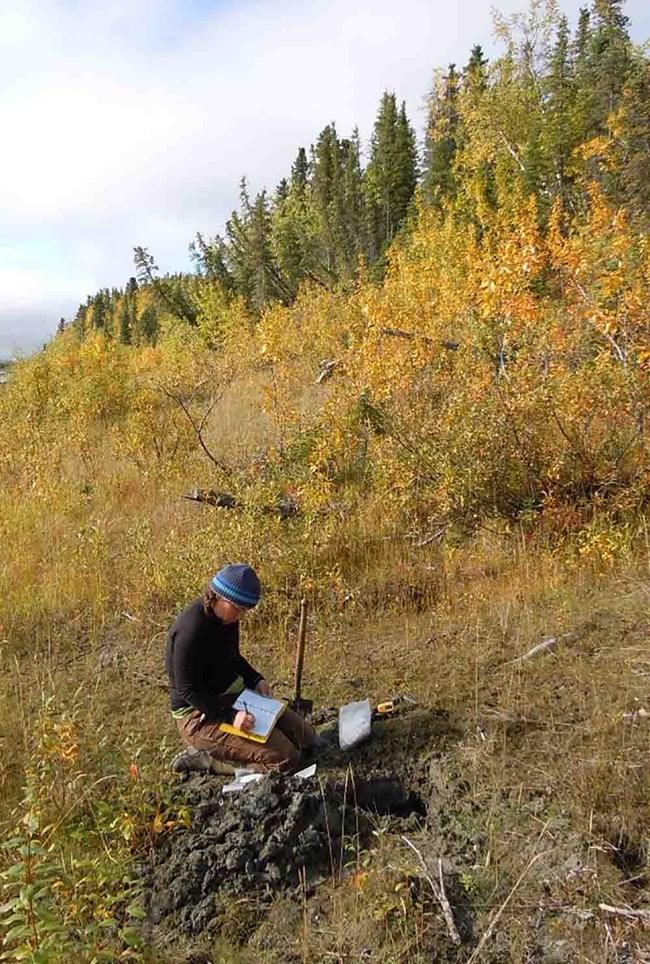
Photo courtesy of Ross Smith
The Bering Strait region was a critical pathway for the initial peopling of North America and has since continued to be a source of ideas, technology, and human movement for thousands of years. While archaeologists have established broader patterns of past interaction and migration, many questions remain about the ways that people, ideas, and technology moved and interacted across the Bering Strait in the past. Our research is directed at studying pre-18th century mobility and cultural interaction in Beringia through analysis of archaeological ceramic technology. The questions we seek to address are: What is the geography of Beringian mobility and social networks over the past 2,500 years and how did these patterns change over time? How does changing mobility relate to other significant social and environmental changes during the mid-late Holocene?
Our previous study of ceramic technology across the Russian Far East, the Chukchi Peninsula, and Alaska (e.g., Anderson et al. 2017, Anderson 2016, Ponkratova 2006, Zhushchikhovskaya 2010a and 2010b) established that ceramics were part of northwestern Alaskan mobility, and interaction networks over the last 1,000 years. These patterns changed over time in relationship to shifting settlement locations (Anderson et al. 2016). The research also indicated the existence of long-term social networks between people living in northwest Alaska and across the broader Bering Strait region (Figure 1). Despite decorative and technological similarities in the pottery found across the region (Dumond and Bland 1995, Ponkratova 2006, Zhushchikhovskaya 2010a), ceramics were not used to explore cross-continent connections in depth until recently (e.g., Anderson et al. 2011).

Figure by Johonna Shea
Bering Strait Pottery
Cooking vessels (the focus of our current work) are the most common ceramic material recovered from sites in the study area, but there are also ceramic bowls, cups, lamps, small clay balls that are likely game pieces (Fienup-Riordan 2005), and figurines reported in small numbers from sites across northern and western Alaska. Ceramic cooking vessels were used in, or suspended above, a small fire or oil lamp to parboil foods, make broths, and for other cooking activities (Anderson 2019). Indirect heating, the placement of rocks heated in a fire or lamp into the ceramic vessel rather than placing the vessel in/above a fire or lamp, is also reported in the ethnographic literature (Anderson 2019; see also Frink and Harry 2008). Clay and stone lamps are found in the study region, and were important for providing both heat and light for homes in the dark months (Lucier and Vanstone 1991). Thus, ceramics were a key technology in a variety of ways for cooking, light, ceremonial practices (Spencer 1959), entertainment, and other activities.
Pottery was made by adding a variety of mineral (sand) and organic (feathers, fur/hair, grass, other fibers, etc.) material to clay to create a paste that was formed using a variety of techniques into the desired shape for the cooking vessels. Formed vessels were air dried and then fired in simple pits. Vessels were sometimes further treated with blood or oil to increase their ability to hold water (Anderson 2019).
Bering Strait ceramic technology likely has its origins in earlier Russian Far East traditions that spread to the Chukotka Peninsula, the Kolyma River basin, and the Okhotsk Sea coast by 5,000 years ago (Ackerman 1982, Dumond and Bland 1995). People adopted ceramic technology in Alaska between 2,500 and 3,000 years ago and ceramic traditions subsequently spread north and south along the coasts of Alaska (Anderson et al. 2017). By 1,000 years ago, pottery was in use as far east as the Mackenzie River in the western Canadian Arctic and as far south as the Kodiak Archipelago.
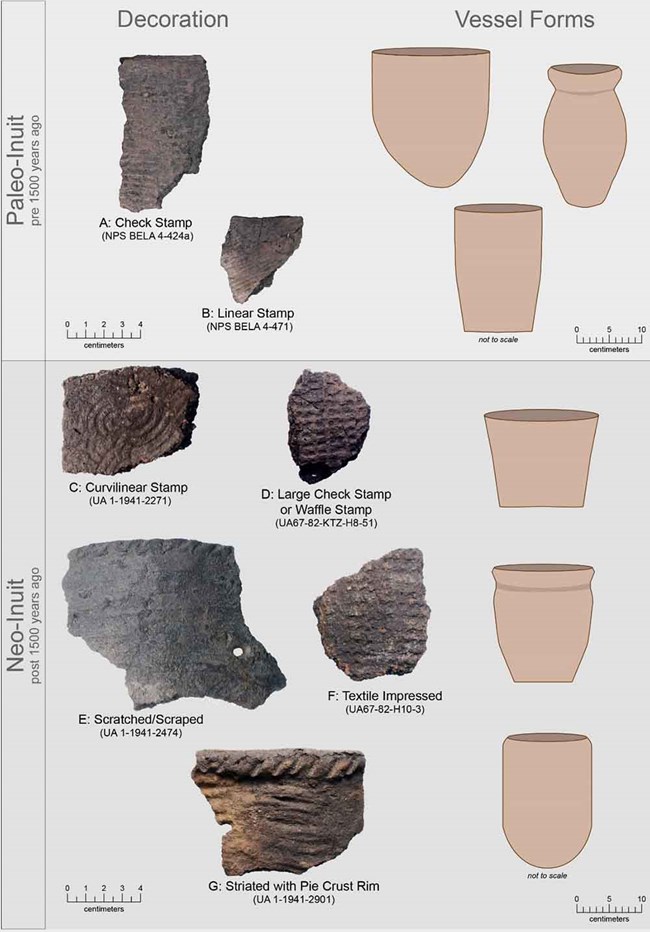
Figure by Johonna Shea
Bering Strait ceramic technology can be classified broadly as falling into two traditions: Paleo-Inuit (pre-1,500 years ago) and Neo-Inuit (post-1,500 years ago) ceramic traditions (Figure 2). While early Paleo-Inuit ceramics are relatively rare, 105 known sites are dated to before 1,500 years ago (Anderson et al. 2017). Neo-Inuit ceramics are more common and are found at most residential sites in the western Arctic dated after 1,000 years ago.
There are regional differences within Paleo- and Neo-Inuit traditions in terms of surface decoration, common temper types, and vessel shapes. Generally, Paleo-Inuit pottery vessels are thinner and harder than Neo-Inuit vessels, which tend to be thick and crumbly. Although sample sizes are small, the earliest Paleo-Inuit pottery vessels appear to have had a rounded bottom and various types of cord marked, linear, or check stamped surface treatments. Later Paleo-Inuit vessels have more of a barrel shape with a flat bottom, although this sample is skewed toward southwest Alaska and may represent a regional variant rather than a broader evolution in Paleo-Inuit ceramic form. There are both flat- and round- or pointed-bottom Neo-Inuit vessels that range in shape from cylindrical to an everted flowerpot shape (Figure 2). In northern and northwest Alaska, organic and mineral temper are common in both Paleo-Inuit and Neo-Inuit vessels, although Neo-Inuit vessels have a much coarser paste texture and higher temper content. Surface treatments include various check, corrugated, and curvilinear stamped patterns, as well as line-dot designs and textile impressions (Oswalt 1955, Dumond 1969, Anderson et al. 2011, Anderson 2019; Figure 2). Changes in ceramic character over time from a higher investment to lower investment (expedient) technology could be related to changing cooking practices. Alternatively, earlier Paleo-Inuit ceramics may have had greater importance in a social context (e.g., as prestige items) than later Neo-Inuit ceramics.
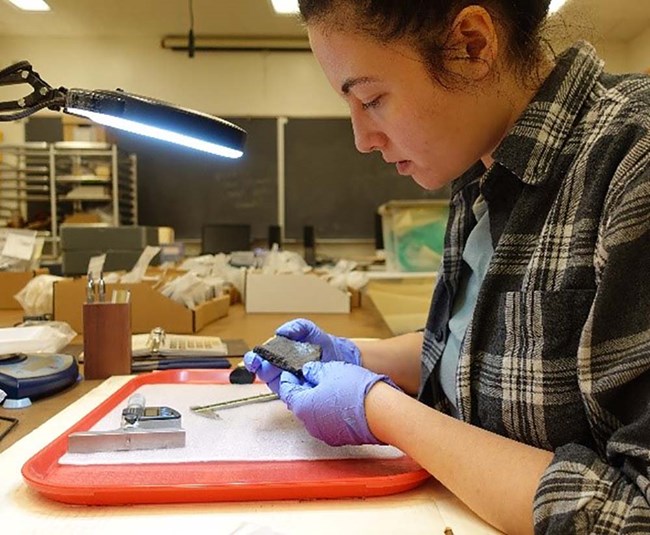
Portland State University/Caelie Butler
Studying Past Beringian Social Networks through Ceramic Analysis
Social networks were, and continue to be, essential to sustained human occupation of Arctic environments. Individuals and groups with wider social connections were more resilient during periods of increased environmental variability and uncertainty, and in the face of social change (Fitzhugh et al. 2016). Social relationships and access to goods, materials, information, and opportunities they create help people cope with environmental and social stresses. This was particularly true in the highly variable mid-late Holocene environment of the Bering Strait region (Tremayne 2018, Minc and Smith 1989, Sheehan 1995, Mason 1998, Rasic 2016). Alaska Natives were connected to the Indigenous exchange systems of Chukotka and Kamchatka prior to Russian entry into Northeast Asia (Bockstoce 2009).
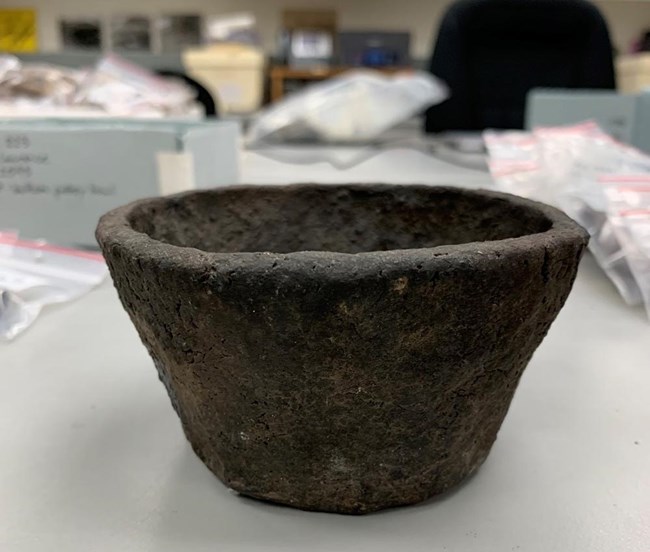
Portland State University/Shelby Anderson
Archaeologists interpret the broad geographic extent of particular cultural traits, such as tool styles and artistic traditions, as evidence of on-going interaction across the Arctic and Subarctic throughout prehistory (Rasic 2016). For example, the pottery associated with Early Neo-Inuit or Birnirk migrations into Alaska has distinct decorations. Iron used for carving intricate bone and ivory decorations over the last 2,000 years is cited as evidence of long-term international trade networks (Mason 1998). The distribution of locally rare materials like ivory and jade (i.e., nephrite) is often considered evidence of exchange across the coast and interior of the Bering Strait region (Alix et al. 2015, Arutiunov et al. 2006, Giddings 1952, Neffe 2015). Sourcing of obsidian (Cook 1995, Reuther et al. 2011), chert (Malyk-Selivanova et al. 1998), metal (McCartney 1986, Cooper and Bowen 2013 Cooper et al. 2016), and glass beads (Kunz and Mills 2021) from northern Alaska indicates pre-18th century networks extended to Chukotka and far beyond. Recent sourcing of ceramics indicates that ceramic vessels were also included in regular, ongoing patterns of mobility and social/technological exchange across the region (Anderson et al. 2011, 2016).
Results of Prior Research
Prior research demonstrated that ceramics were incorporated into pre-contact mobility/exchange networks and ceramic research has significant potential for understanding past cultural exchange and interaction in the Arctic (Anderson et al. 2011, 2016). Over the last 1,000 years, people in northwest Alaska were tightly connected within the region and probably maintained regular ties with groups living to the north and south, and likely Indigenous peoples of Chukotka as well (Anderson 2016, Anderson et al. 2016). Prior analysis identified intriguing geographic patterns to these interaction networks. People brought their ceramic vessels with them, and/or may have exchanged vessels, as they moved seasonally upriver and downriver between large coastal sites and smaller coastal and interior sites. Ceramics from the central part of the Kobuk River appear to have spread extensively across the region. It is possible that ceramics were regularly moving across mountain ranges and between river valleys as part of exchange and/or seasonal movements (Figure 3). The mobility patterns indicated by ceramic sourcing are interesting because they provide more specific information about how people moved seasonally around the region than was previously available for the pre-Colonial period.

Several rare ceramic source groups (Groups 1B, 1C) probably came from outside northwest Alaska, perhaps from Chukotka or the Norton Sound region.
Figure by Johonna Shea
Pottery surface decorations also show con-nections across the region and beyond. For example: corrugated decorative type is from northern Kotzebue Sound and horizontal lined type is from Norton Sound; Both decorative types are found at sights across Northwest Alaska and the Bering Strait regions. The decorations may have been imitated or the ceramic vessels themselves brought from other areas. Either scenario indicates social ties between these regions. These pre-18th century networks mirror exchange networks reported in the ethnographic literature (Burch 1998 and 2005, Paneak 2004, Lee 1992, Spencer 1959, Spray 2002, Ray 1975). The Seward Peninsula assemblages consist of sources and surface treatments not observed elsewhere within Northwest Alaska, which could be the result of mobility and exchange across the Bering Strait with Chukotka peoples.
Temporal trends in networks are more difficult to assess because of uneven sample sizes over the last 1,000 years. For example, in the northern and central regions of northwest Alaska, there is a reduction in the number of source areas used over the last 1,000 years, and particularly after 500 years ago. There are also changes in the distribution of ceramic samples across sources before and after 500 years ago. These temporal shifts could be related to larger population movements (e.g., Neo-Inuit migration, late pre-colonial/colonial period population shifts). Interpretations of temporal patterns should be treated with caution until the results of additional analysis are available.
To address questions raised by our prior work, we are expanding our study to new locales that will be key to identifying links across the Bering Strait over the last several millennia (Figure 4). We are also expanding our sample of older Paleo-Inuit ceramics and obtaining new radiocarbon dates for key Paleo-Inuit sites. Paleo-Inuit ceramics in Alaska are thought to date back to 2,500-2,800 years ago.

Figure by Johonna Shea
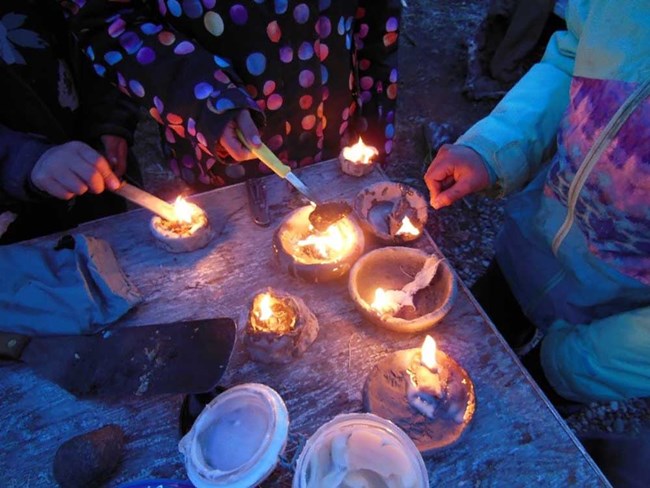
Portland State University/Caelie Butler
On-going Work: Contextualizing Past Social Networks with Contemporary Community Knowledge
While archaeologists have established broader patterns of past migration, many questions remain about the ways that people, ideas, and technology moved and interacted across the Bering Strait. New research is directed at studying pre-18th century mobility and cultural interaction in Beringia through analysis of archaeological ceramic technology. Our study of ceramic technology expands what we know about the extent of social networks over time, and how these networks shifted as people adapted to changing environmental and social circumstances.
Additionally, we are building new connections between archaeologists and Indigenous communities across the Bering Strait region to share knowledge about ceramic traditions and social networks. We are collaborating in a variety of ways, including creating a database of Alaskan archaeological collections that are housed at museums and other institutions around the world. The database will be shared with communities and will be searchable by the public through a web-based map interface. The goal is to exchange ideas about past and present pottery and food preparation practices across the Bering Strait region. It is only through collaboration that we can contextualize and appreciate how pottery tools were, and are, part of larger shared traditions across the Bering Strait region.
Acknowledgements
This project is funded by the National Park Service (NPS) through a cooperative agreement between the Shared Beringian Heritage Program and Portland State University. We are studying archaeological collections from the traditional lands of the Iñupiat, Yup/ik/Cup’ik, Aivuqaq (St. Lawrence Island) Yupik, Ungazigmit (Chaplino) Yupik, and the Nyvukagmit (Naukan) peoples of northern Alaska and Bering Strait region. The Museum of the North, the Danish National Museum, the Haffenreffer Museum, the Maxwell Museum, the NPS Regional Archives in Anchorage, the Bureau of Land Management, and NPS Western Arctic Parklands staff are supporting this project through collections access and other research support. The Missouri Research Reactor Archaeometry Lab is carrying out geochemical sourcing. Collaboration with the community of Igiugig was funded by the National Science Foundation Archaeology and Arctic Social Sciences Programs Award #1749078 to Shelby Anderson, and supported by the community of Igiugig and Monty Rogers of Cultural Alaska. Caelie Butler, Kathryn Berg, and Annalisa Heppner all made significant contributions to this project.
References
Ackerman, R. E. 1982.
The Neolithic-Bronze age cultures of Asia and the Norton phase of Alaskan prehistory. Arctic Anthropology 19(2): 11-38.
Alix, C., O. Mason, N. Bigelow, S. Anderson, and J. Rasic. 2015.
Archéologie du cap Espenberg ou la question du Birnirk et de l’origine du Thulé dans le nord-ouest de l’Alaska (Cape Espenberg Archaeology: The Issue of Birnirk and the Origin of Thule in Northwestern Alaska). Les Nouvelles de l’archélogie 141: 13-19.
Anderson, D. D. 1975.
Trade networks among the Selawik Eskimos, Northwestern Alaska, during the late 19th and early 20th centuries. Folk 16–17: 63-72.
Anderson, S. 2016.
A Clay source provenance survey in Northwest Alaska: Late Holocene ceramic production in the Arctic. Journal of Field Archaeology 41(3): 1-17.
Anderson, S., M. T. Boulanger, M. D. Glascock, and R. B. Perkins. 2016.
Geochemical investigation of late pre-contact ceramic production patterns in Northwest Alaska. Journal of Archaeological Science: Reports 6: 200-210.
Anderson, S. 2019.
Ethnographic and archaeological perspectives on the use life of Alaskan Pottery, in Circumpolar Ceramics: A New Research Paradigm for Hunter-Gatherer Technology, K. Gibbs and P. Jordan (eds). Cambridge University Press, pp. 128-151.
Anderson, S., M. T. Boulanger, and M. D. Glascock. 2011.
A new perspective on Late Holocene social interaction in Northwest Alaska: Results of a preliminary ceramic sourcing study. Journal of Archaeological Science 38(5): 943-955.
Anderson, S., S. Tushingham, and T. Y. Buonasera. 2017.
Aquatic adaptations and the adoption of Arctic pottery technology: Results of residue analysis. American Antiquity 82(3): 1-28.
Arutiunov, S. A. and D. A. Sergeev. 2006.
Problems of Ethnic History in the Bering Sea: the Ekven Cemetery. Shared Beringian Heritage Program.
Bockstoce, J. R. 2009.
Furs and Frontiers in the Far North. Yale University Press.
Burch, E. S., Jr. 1998.
The Inupiaq Eskimo Nations of Northwest Alaska. University of Alaska Press.
Burch, E. S., Jr. 2005.
Alliance and Conflict: The World System of the Inupiaq Eskimos. University of Nebraska Press.
Cook, J. P. 1995.
Characterization and distribution of obsidian in Alaska. Arctic Anthropology 32(1): 92-100.
Cooper, H. K. and G. J. Bowen. 2013.
Metal armor from St. Lawrence Island. Arctic Anthropology 50(1): 1-19.
Cooper, H. K., O. K. Mason, V. Mair, J. F. Hoffecker, and R. J. Speakman. 2016.
Evidence of Eurasian metal alloys on the Alaskan coast in prehistory. Journal of Archaeological Science 74: 176-183.
Dumond, D. E. 1969.
The Prehistoric pottery of Southwestern Alaska. Anthropological Papers of the University of Alaska 14(2): 18-42.
Dumond, D. E. and R. L. Bland. 1995.
Holocene prehistory of the northernmost North Pacific. Journal of World Prehistory 9(4): 401-451.
Fienup-Riordan, A. 2005.
Yup’ik Elders at the Ethnologisches Museum Berin: Fieldwork Turned on its head. Seattle: University of Washington Press.
Fitzhugh, B., E. W. Gjesfjeld, W. A. Brown, M. J. Hudson, and J. D. Shaw. 2016.
Resilience and the population history of the Kuril Islands, Northwest Pacific: A study in complex human ecodynamics. Quaternary International 419: 165-193.
Frink, L. and K. Harry. 2008.
The beauty of “ugly” Eskimo cooking pots. American Antiquity 73(1): 103-118.
Giddings, J. L. 1952.
The Arctic Woodland Culture of the Kobuk River, University Museum Monograph. University of Pennsylvania.
Kunz, M. L. and R. O. Mills. 2021.
A Precolumbian presence of Venetian glass trade beads in Arctic Alaska. American Antiquity 86(2):1-18.
Lee, C. 1992.
Ambler, Alaska, in Lore of the Inupiat: The Elders Speak, L. Lee, R. Sampson, and E.(eds). Northwest Arctic Borough School District.
Lucier, C. V. and J. W. Vanstone. 1991.
The Traditional Oil Lamp among Kangigmiut and Neighboring Iñupiat of Kotzebue Sound, Alaska. Arctic Anthropology 28(2):1-14.
Malyk-Selivanova, N., G. M. Ashley, R. Gal, M. D. Glascock, and H. Neff. 1998.
Geological-geochemical approach to “sourcing” of prehistoric chert artifacts, Northwestern Alaska. Geoarchaeology 13(7): 673-708.
Mason, O. K. 1998.
The contest between the Ipiutak, Old Bering Sea, and Birnirk polities and the origin of whaling during the First millennium A.D. along Bering Strait. Journal of Anthropological Archaeology 17(3): 240-325.
McCartney, A. P. 1986.
Late prehistoric metal use in the New World Arctic, in Late Prehistoric Development of Alaska’s Native People, R. D. Shaw, R. K. Harritt, and D. E. Dumond (eds). Alaska Historical Commission, pp. 88-123.
Minc, L. D. and K. P. Smith. 1989.
The spirit of survival: cultural responses to resource variability in North Alaska, in Bad Year Economics: Cultural Responses to Uncertainty and Risk, P. Halstead and J. O’Shea (eds). Cambridge University Press, pp. 8-39.
Neffe, A. 2015.
‘Faisons parler les pierres Le jade de la préhistoire récente de l’Alaska’. Les Nouvelles de l’archélogie 141: 25-31.
Oswalt, W. 1955.
Alaskan pottery: A classification and historical reconstruction. American Antiquity 21(1): 32-43.
Paneak, S. 2004.
In a Hungry Country: Essays by Simon Paneak. J. M. Campbell (ed.). University of Alaska Press.
Ponkratova, I. 2006.
Pottery industries in the North of the Russian Far East, in Archaeology in Northeast Asia: On the Pathway to Bering Strait, D. E. Dumond and R. L. Bland (eds). Museum of Natural and Cultural History and Department of Anthropology, University of Oregon, pp. 129-158.
Rasic, J. T. 2016.
Transport, Trade, and Exchange in the North American Arctic, in The Oxford Handbook of the Prehistoric Arctic, T.M. Friesen and O.K. Mason (eds). Oxford University Press, pp. 131-152.
Ray, D. J. 1975.
The Eskimos of Bering Strait, 1650-1898. University of Washington Press.
Reuther, J. D., N. S. Slobodina, J. R. Rasic, J. P. Cook, and R. J. Speakman. 2011.
Gaining momentum: Late Pleistocene and Early Holocene archaeological obsidian source studies in Interior and Northeastern Beringia, in From the Yenisei to the Yukon: Interpreting Lithic Assemblage Variability in Late Pleistocene/Early Holocene Beringia, T. Goebel, T. and I. Buvit, (eds). Texas A&M University Press, pp. 270-286.
Sheehan, G. W. 1995.
Whaling surplus, trade, war, and the integration of prehistoric Northern and Northwestern Alaskan economies, A.D. 1200-1826, in Hunting the Largest Animals: Native Whaling in the Western Arctic and Subarctic, A.P. McCartney (ed.). Canadian Circumpolar Institute (CCI) Press, pp. 185-206.
Spencer, R. F. 1959.
The North Alaskan Eskimo: A Study in Ecology and Society. U.S. Govt. Printing Office.
Spray, Z. 2002.
Alaska’s vanishing Arctic cuisine. Gastronomica 2(1): 30-40.
Tremayne, A. H. 2018.
A survey of human migration in Alaska’s national parks through time. Alaska Park Science 17(1): 5-15.
Zhushchikhovskaya, I. S. 2010a.
Pottery making in prehistoric cultures of the Russian Far East, in Ceramics Before Farming: The Dispersal of Pottery Among Prehistoric Eurasian Hunter-Gatherers, P. Jordan and M. Zvelebil (eds). Left Coast Press, Inc., pp. 121-147.
Zhushchikhovskaya, I. S. 2010b.
Pottery making of Sakhalin Island in historical dynamics: From the Neolithic to the Paleometal period. Arctic Anthropology 47(2): 42-58.
Last updated: February 20, 2024
